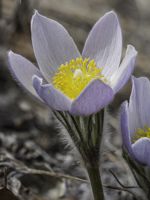Mon-Fri 9am - 5pm Mountain time
Anthony Waterer Spiraea vs Prairie Crocus
Spiraea japonica Anthony Waterer
Pulsatilla nuttalliana (Anemone patens)
CUSTOM GROW
NOT AVAILABLE THIS SEASON - MIGHT RETURN
Anthony Waterer Spiraea is a low maintenance shrub with a dwarf, rounded form. In spring and summer rosy pink blooms emerge against green foliage. Its tolerance of a variety of well-drained soils makes it an ideal foundation, landscaping, or border plant.
If deer and rabbit are an issue on your property, consider planting Anthony Waterer Spiraea for its deer/rabbit resistance. Due to its compact form, minimal pruning is required.
Prairie Crocus is a native perennial wildflower that is often considered one of the first signs of spring. The flowers can range from purple, pale blue, to white and often appear before the snow has fully melted. It can bloom a month earlier than other spring flowers, providing an early source of pollen for a variety of pollinators.
The plant is covered in woolly white hairs, including the finely divided leaves, giving them a silvery appearance. Prairie Crocus leaves do not fully emerge until after it has bloomed. The spent blooms transform into fluffy, feathery seed heads. During the hot summer months, the Prairie Crocus goes dormant and will repeat its life cycle the following spring.
The Prairie Crocus is Manitoba’s provincial flower.
Anthony Waterer Spiraea Quick Facts
Prairie Crocus Quick Facts
Toxicity: all parts toxic if eaten, sap can irritate skin

